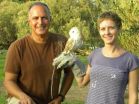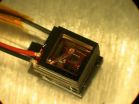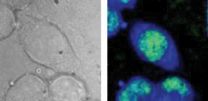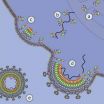(Press-News.org) PHILADELPHIA — An article published in the Ffall 2010 issue of CR, the AACR's magazine for cancer survivors and their families and caregivers, details the immense challenges faced by those who suffer with cancer and lack the necessary resources for proper treatment and care — the homeless.
CR magazine contributing writer Cynthia Ryan, Ph.D., who is an associate professor of English at the University of Alabama at Birmingham, took to the streets over the last year to offer a glimpse into the lives of homeless cancer patients struggling to obtain treatment while being confronted by daily uncertainties about life's most basic necessities.
What makes this story even more unique is that Ryan, a 17-year breast cancer survivor, can relate firsthand to the harbored fears and uncertainties that many patients experience when diagnosed with cancer.
"Those who experience cancer on the streets brave a constant struggle to find a place where they can belong. … And while all survivors embark on a journey unlike any other when diagnosed with cancer, the homeless trudge a more treacherous path," Ryan wrote in CR.
Along her journey, Ryan learned more about the complexities of this population than she had thought she would. She developed unique bonds with many homeless cancer patients, but one in particular — 46-year-old Edwina Sanders, a stage 4 breast cancer patient — left a lasting impact.
"[The homeless] have challenges beyond just the effects of cancer. People like Edwina simply struggle to find a way to get to their appointments and to get 'home' after chemotherapy," Ryan said in a video podcast with the AACR.
Ryan said that writing this article confirmed her belief that simplifying the experience of cancer to a single narrative of diagnosis, treatment and recovery is not only misleading, but also harmful to those who aren't represented in purely 'hopeful' profiles of survivorship.
"You go into these communities assuming you are going to lift these people up; you're going to help them. What you find in return is they give a lot back to you," she said. "When I see Edwina, I see the face of cancer in all its rawness. She reminds me that cancer is a formidable opponent and that our fight is far from over."
###
This October celebrates the 25th Anniversary of National Breast Cancer Awareness Month. Ryan and Sanders are both available for interviews by contacting the AACR.
To read Ryan's story "Homeless With Cancer," in the Fall fall 2010 issue of CR magazine, please visit: www.CRmagazine.org/archive/Fall2010/Pages/HomelessWithCancer.aspx
To listen to CR's "Cancer on the Streets" audio podcast, please visit: www.CRmagazine.org/archive/Crpodcasts/Pages/CancerontheStreets.aspx
To view the video podcast interview with Ryan, which was conducted during the Third AACR Conference on The Science of Cancer Health Disparities, please visit: www.aacr.org/page22693.aspx
The mission of the American Association for Cancer Research is to prevent and cure cancer. Founded in 1907, the AACR is the world's oldest and largest professional organization dedicated to advancing cancer research. The membership includes 32,000 basic, translational and clinical researchers; health care professionals; and cancer survivors and advocates in the United States and more than 90 other countries. The AACR marshals the full spectrum of expertise from the cancer community to accelerate progress in the prevention, diagnosis and treatment of cancer through high-quality scientific and educational programs. It funds innovative, meritorious research grants, research fellowships and career development awards. The AACR Annual Meeting attracts more than 18,000 participants who share the latest discoveries and developments in the field. Special conferences throughout the year present novel data across a wide variety of topics in cancer research, treatment and patient care. The AACR publishes six major peer-reviewed journals: Cancer Research; Clinical Cancer Research; Molecular Cancer Therapeutics; Molecular Cancer Research; Cancer Epidemiology, Biomarkers & Prevention; and Cancer Prevention Research. The AACR also publishes CR, a magazine for cancer survivors and their families, patient advocates, physicians and scientists, providing a forum for sharing essential, evidence-based information and perspectives on progress in cancer research, survivorship and advocacy.
END
BUFFALO, N.Y. -- Cyber attacks of various sorts have been around for decades. The most recent, and very dangerous, escalation in the past few years has been marked by countries launching attacks against other nations, such as Stuxnet, the nuclear plant-disrupting worm the Iranians have blamed on Israel and the U.S., while others are pointing the finger at Russia.
University at Buffalo military ethicist Randall R. Dipert, PhD, one of the founders of the National Center for Ontological Research at UB, says we have good reason to worry, because cyber attacks are almost ...
Anxiety, or the reaction to a perceived danger, is a response that differs from one animal or human to another ― or so scientists thought. Now researchers at Tel Aviv University are challenging what we know about stress, and their study has implications for helping clinicians better treat victims of terrorism or natural disasters.
Prof. David Eilam and his graduate student Rony Izhar of Tel Aviv University's Department of Zoology are spearheading a study designed to investigate the anxieties experienced by an entire social group. Using the natural predator-and-prey ...
Researchers from the National Institute of Standards and Technology (NIST) and the German national metrology institute have used NIST's miniature atom-based magnetic sensor to successfully track a human heartbeat, confirming the device's potential for biomedical applications.
Described in Applied Physics Letters,* the study is the first to be performed under conditions resembling a clinical setting with the NIST mini-sensors, which until now have been operated mostly in physics laboratories. The new experiments were carried out at the Physikalisch Technische Bundesanstalt ...
TORONTO, ON – Evolutionary biologists at the University of Toronto (U of T) have found that environment plays a key role in determining whether a species opts for sexual over asexual reproduction.
The study, led by post-doctoral student Lutz Becks and Professor Aneil Agrawal of the Department of Ecology & Evolutionary Biology, found that species that inhabit spatially heterogenous environments – habitats characterized by uneven concentrations of its own species among a rich variety of other animals and plants – had higher rates of sexual reproduction than those in more ...
A paper by researchers at the National Institute of Standards and Technology (NIST) may breathe new life into the use of a powerful—but tricky—diagnostic technique for cell biology. The paper,* appearing this week in the Biophysical Journal, demonstrates that with improved hardware and better signal processing, a powerful form of molecular vibration spectroscopy can quickly deliver detailed molecular maps of the contents of cells without damaging them. Earlier studies have suggested that to be useful, the technique would need power levels too high for cells.
The technique, ...
New insights into the human immunodeficiency virus (HIV) infection process, which leads to acquired immunodeficiency syndrome (AIDS), may now be possible through a research method recently developed in part at the National Institute of Standards and Technology (NIST), where scientists have glimpsed an important protein molecule's behavior with unprecedented clarity.
The HIV protein, known as Gag, plays several critical roles in the assembly of the human immunodeficiency virus in a host cell, but persistent difficulties with imaging Gag in a lab setting have stymied researchers' ...
CHAMPAIGN, Ill. – A new law aimed at helping stimulate small business job growth through tax deductions could have major consequences for anyone with a retirement savings account at work, a University of Illinois expert on taxation and elder law notes.
Law professor Richard L. Kaplan says an obscure provision in the recently enacted Small Business Jobs Act allows 401(k), 403(b) or 457 account holders to convert their retirement savings into a tax-advantaged Roth-version of the same account.
The good news, according to Kaplan, is that by converting to a Roth variant, ...
Researchers at the National Institute of Standards and Technology (NIST) have demonstrated* for the first time the conversion of near-infrared 1,300 nm wavelength single photons emitted from a true quantum source, a semiconductor quantum dot, to a near-visible wavelength of 710 nm. The ability to change the color of single photons may aid in the development of hybrid quantum systems for applications in quantum communication, computation and metrology.
Two important resources for quantum information processing are the transmission of data encoded in the quantum state of ...
Removing the toxic and odorous emissions of ammonia from the industrial production of fertilizer is a costly and energy-intensive process. Now, researchers in Bangladesh have turned to microbes and inexpensive wood charcoal to create a biofilter that can extract the noxious gas from vented gases and so reduce pollution levels from factories in the developing world.
Writing in the International Journal of Environment and Pollution, Jahir Bin Alam, A. Hasan and A.H. Pathan of the Department of Civil and Environmental Engineering, at Shahjalal University of Science and Technology, ...
JACKSONVILLE, Fla. — Physicians at Mayo Clinic's Florida campus are among the first in the nation to use a technique known as MRI-guided laser ablation to heat up and destroy kidney and liver tumors. So far, five patients have been successfully treated — meaning no visible tumors remained after the procedure.
They join their colleagues at Mayo Clinic's site in Rochester, Minn., who were the first to use laser ablation on patients with recurrent prostate tumors.
Although the treatment techniques are in the development stage, the physicians say the treatment is potentially ...





